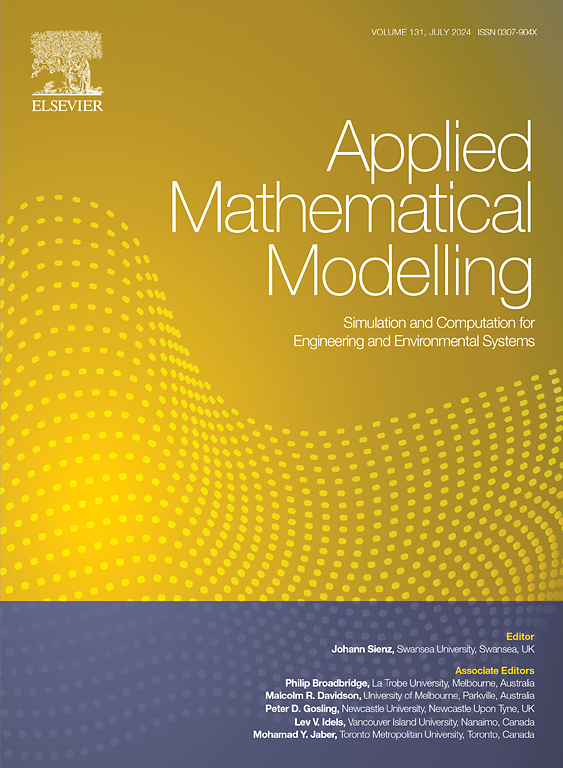A Gegenbauer-polynomial-based semi-analytical approach for dynamic modeling of series-parallel pipe systems under elastic boundary conditions
IF 4.4
2区 工程技术
Q1 ENGINEERING, MULTIDISCIPLINARY
引用次数: 0
Abstract
This study introduces a Gegenbauer-polynomial-based semi-analytical approach (GP-SAA) for dynamic modeling of series-parallel pipe (SPP) systems under elastic boundary conditions. By leveraging the Timoshenko beam theory, energy formulations for straight and curved pipes, single and dual clamps, and pipe joints are derived. The Virtual Spring Technology (VST), which effectively models the dynamic coupling effects arising from pipe-pipe, clamp-pipe, and pipe-connector interactions, is employed to establish elastic boundary conditions. To ensure the numerical accuracy and computational efficiency of the GP-SAA framework, a systematic convergence analysis of key parameters is performed. A prototype of the SPP system and its finite element (FE) model are independently developed to benchmark the proposed methodology via the experimental modal analysis. Convergence studies based on multiple realizations of the polynomial parameter are conducted to identify a proper truncation term for the GP-SAA. Furthermore, parametric investigations into critical factors such as pipe geometry, clamp positions, and connector locations are performed to investigate their combined effects on natural frequency characteristics of the SPP system. Numerical results demonstrate the effectiveness and potential applicability of the GP-SAA for dynamic modeling of SPP systems in general.
弹性边界条件下串并联管道系统动力学建模的基于gegenbauer -多项式的半解析方法
提出了一种基于gegenbauer -多项式的半解析方法(GP-SAA),用于弹性边界条件下串并联管道(SPP)系统的动力学建模。利用Timoshenko光束理论,推导了直管和弯管、单卡箍和双卡箍以及管接头的能量公式。采用虚拟弹簧技术(VST)建立弹性边界条件,该技术可以有效地模拟由管道-管道、夹管-管道和管道-连接器相互作用引起的动态耦合效应。为了保证GP-SAA框架的数值精度和计算效率,对关键参数进行了系统的收敛分析。独立开发了SPP系统的原型及其有限元模型,通过实验模态分析对所提出的方法进行了基准测试。基于多项式参数的多种实现进行收敛性研究,以确定GP-SAA的合适截断项。此外,还对关键因素进行了参数化研究,如管道几何形状、夹具位置和连接器位置,以研究它们对SPP系统固有频率特性的综合影响。数值结果证明了GP-SAA在SPP系统动力学建模中的有效性和潜在的适用性。
本文章由计算机程序翻译,如有差异,请以英文原文为准。
求助全文
约1分钟内获得全文
求助全文
来源期刊

Applied Mathematical Modelling
数学-工程:综合
CiteScore
9.80
自引率
8.00%
发文量
508
审稿时长
43 days
期刊介绍:
Applied Mathematical Modelling focuses on research related to the mathematical modelling of engineering and environmental processes, manufacturing, and industrial systems. A significant emerging area of research activity involves multiphysics processes, and contributions in this area are particularly encouraged.
This influential publication covers a wide spectrum of subjects including heat transfer, fluid mechanics, CFD, and transport phenomena; solid mechanics and mechanics of metals; electromagnets and MHD; reliability modelling and system optimization; finite volume, finite element, and boundary element procedures; modelling of inventory, industrial, manufacturing and logistics systems for viable decision making; civil engineering systems and structures; mineral and energy resources; relevant software engineering issues associated with CAD and CAE; and materials and metallurgical engineering.
Applied Mathematical Modelling is primarily interested in papers developing increased insights into real-world problems through novel mathematical modelling, novel applications or a combination of these. Papers employing existing numerical techniques must demonstrate sufficient novelty in the solution of practical problems. Papers on fuzzy logic in decision-making or purely financial mathematics are normally not considered. Research on fractional differential equations, bifurcation, and numerical methods needs to include practical examples. Population dynamics must solve realistic scenarios. Papers in the area of logistics and business modelling should demonstrate meaningful managerial insight. Submissions with no real-world application will not be considered.
 求助内容:
求助内容: 应助结果提醒方式:
应助结果提醒方式:


